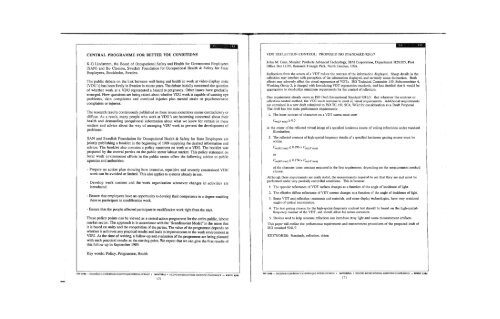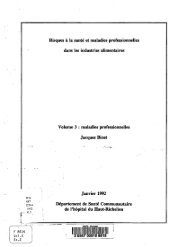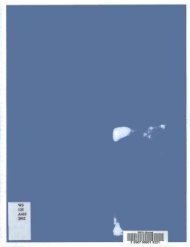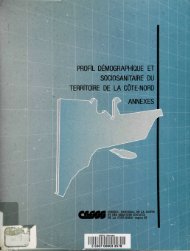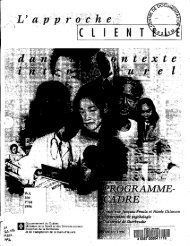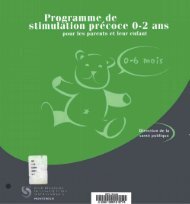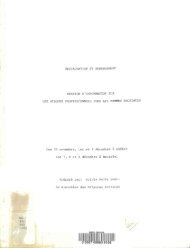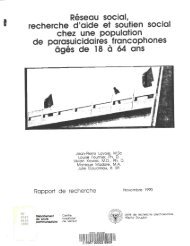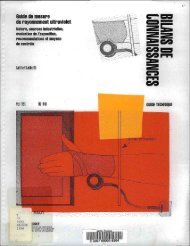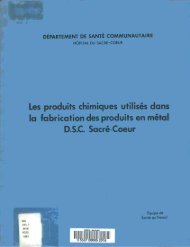le travail à l'écran de visualisation work with display units
le travail à l'écran de visualisation work with display units
le travail à l'écran de visualisation work with display units
You also want an ePaper? Increase the reach of your titles
YUMPU automatically turns print PDFs into web optimized ePapers that Google loves.
CENTRAL PROGRAMME FOR BETTER VDU CONDITIONSK-G Lindstrôm, the Board of Occupational Safety and Health for Government Employees(SAN) and Bo Claeson, Swedish Foundation for Occupational Health & Safety for StateEmployees, Stockholm, Swe<strong>de</strong>n.The public <strong>de</strong>bate on the link between well-being and health in <strong>work</strong> at vi<strong>de</strong>o <strong>display</strong> <strong>units</strong>(VDU's) has been lively in Swe<strong>de</strong>n in recent years. The <strong>de</strong>bate initially concerned the questionof whether <strong>work</strong> at a VDU represented a hazard to pregnancy. Other issues have graduallyemerged. Now questions are being raised about whether VDU <strong>work</strong> is capab<strong>le</strong> of causing eyeprob<strong>le</strong>ms, skin complaints and overload injuries plus mental strain or psychosomaticcomplaints or injuries.The research results continuously published on these issues sometimes seems contradictory ordiffuse. As a result, many peop<strong>le</strong> who <strong>work</strong> at VDU's are becoming concerned about theirhealth and <strong>de</strong>manding unequivocal information about what we know for certain in thesematters and advice about the way of arranging VDU <strong>work</strong> to prevent the <strong>de</strong>velopment ofprob<strong>le</strong>ms.SAN and Swedish Foundation for Occupational Health & Safety for State Employees arejointly publishing a book<strong>le</strong>t in the beginning of 1989 supplying the <strong>de</strong>sired information andadvice. The book<strong>le</strong>t also contains a policy statement on <strong>work</strong> at a VDU. The book<strong>le</strong>t wasprepared by the central parties on the public sector labour market. This policy statement onlocal <strong>work</strong> environment efforts in the public sector offers the following advice to publicagencies and authorities:- Prepare an action plan showing how intensive, repetitive and severely constrained VDU<strong>work</strong> can be avoi<strong>de</strong>d or limited. This also applies to systems already in use.- Develop <strong>work</strong> content and the <strong>work</strong> organization whenever changes in activities areintroduced.- Ensure that employees have an opportunity to <strong>de</strong>velop their competence to a <strong>de</strong>gree enablingthem to participate in modification <strong>work</strong>.- Ensure that the peop<strong>le</strong> affected participate in modification <strong>work</strong> right from the start.These policy points can be viewed as a central action programme for the entire public, labourmarket sector. The approach is in accordance <strong>with</strong> the "Scandinavian Mo<strong>de</strong>l" in the sense thatit is based on unity and the cooperation of the parties. The value of the programme <strong>de</strong>pends onwhether it achieves any practical results and <strong>le</strong>ads to improvements in the <strong>work</strong> environment atVDU. At the time of writing, a follow-up and evaluation of the programme are being planned<strong>with</strong> such practical results as the starting point. We expect that we can give the first results ofthis follow-up in September 1989.VDT REFLECTION CONTROL: PROPOSED ISO STANDARD 9241/7John M. Cone, Monitor Products Advanced Technology, IBM Corporation, Department H29/205, PostOffice Box 12195, Research Triang<strong>le</strong> Park, North Carolina, USA.Ref<strong>le</strong>ctions from the screen of a VDT reduce the contrast of the information <strong>display</strong>ed. Sharp <strong>de</strong>tails in theref<strong>le</strong>ction may interfere <strong>with</strong> perception of the information <strong>display</strong>ed, and certainly cause distraction. Botheffects may adversely affect the visual ergonomics of VDTs. ISO Technical Committe 159, Subcommittee 4,Working Group 2, is charged <strong>with</strong> formulating VDT ergonomics standards, and has <strong>de</strong>ci<strong>de</strong>d that it would beappropriate to standardize minimum requirements for the control of ref<strong>le</strong>ction.One requirement already exists in ISO Draft International Standard 9241/3: that whatever the contrast orref<strong>le</strong>ction control method, the VDT must continue to meet all visual requirements.. Additional requirementsare contained in a new draft submitted to ISO TC 159, SC4, WG2 for consi<strong>de</strong>ration as a Draft Proposal.The draft has two main performance requirements:1. The inner contrast of characters on a VDT screen must meetC m(LF max) ^in the center of the ref<strong>le</strong>cted virtual image of a specified luminous source of veiling ref<strong>le</strong>ctions un<strong>de</strong>r standardillumination.2. The ref<strong>le</strong>cted contrast of high-spatial-frequency <strong>de</strong>tails of a specified luminous grating source must be<strong>with</strong>inC m(HF max) -orxC m(LF max)Cm(HF max) - 0-174 X C m(LF max )of the character inner contrast measured in the first requirement, <strong>de</strong>pending on the measurement methodchosen.Although these requirements are easily stated, the measurements required to see that they are met must beperformed un<strong>de</strong>r very precisely control<strong>le</strong>d conditions* This is because:1. The specular ref<strong>le</strong>ctance of VDT surfaces changes as a function of the ang<strong>le</strong> of inci<strong>de</strong>nce of light.2. The effective diffuse ref<strong>le</strong>ctance of VDT screens changes as a function of the ang<strong>le</strong> of inci<strong>de</strong>nce of light.3. Some VDT anti-ref<strong>le</strong>ction treatments and materials, and some <strong>display</strong> technologies, have very restrictedang<strong>le</strong>s of optical transmission.4. The test grating chosen for the high-spatial-frequency contrast test should be based on the high-spatialfrequencycontent of the VDT, and should allow for screen curvature.5. Devices used to help measure ref<strong>le</strong>ctions can introduce stray light and cause measurement artifacts.This paper will outline the performance requirements and measurement procedures of the proposed draft ofISO standard 9241/7.KEYWORDS: Standards, ref<strong>le</strong>ction, visionKey words: Policy, Programme, HealthTEV 1989 -DEUXIÈME CONFÉRENCE SCIENTIFIQUE INTERNATIONALE • MONTRÉAL • SECOND INTERNATIONAL SCIENTIFIC CONFERENCE - WDU 1989170TEV 1989— DEUXIÈME CONFÉRENCE SCIENTIFIQUE INTERNATIONALE • MONTRÉAL • SECOND INTERNATIONAL SCIENTIFIC CONFERENCE — WWDU 1989171


